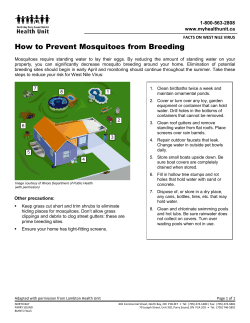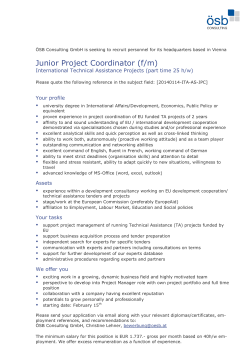
Public-Private-Partnerships in Plant Breeding Research
Public-Private-Partnerships in Plant Name der Veranstaltung Breeding Research within Germany VeranstaltungWorkshop (Zeit, Ort)Public-Private International Partnerships on Pre-breeding February 2-4, Montpellier, France Name des Autors, Position Dr. Petra Jorasch, Vice Secretary General of GFP and BDP German System of Public Private Partnership in the Field of Pre competitive Research Content Plant PPP Breeding in Germany in Plant Breeding Research • the GFP-model • Genomic research program – GABI, Plant 2030 and Plant KBBE • proWheat EVA II – PPP for Evaluation of PGR Conclusions Plant Breeding in Germany Breeding companies • 130 plant breeding and seed trading companies (of which 58 breeding companies with own breeding programs) • seed market volume EUR 900 million in Germany (plus 70,0 % exports) • 5,773 staff (breeding, excluding seed production) thereof 2.364 R&D staff • 15.1 % R&D-to-turnover ratio • 3,500 ha breeding nurseries • 225,000 m² greenhouse area • > 3000 total varieties listed Number of Breeding Programs per Crop(s) 12 3 7 23 8 11 Sugar Beet Maize Cereals Potato Quelle: BDP, 2014 fünfjährliche F&E Umfrage 4 19 Oil& Protein Veregables Fodder Plants Ornamentals Mission of GFP stimulates innovation is central contact point and communication platform represents the interests of plant breeding companies with regard to plant breeding research stimulates public funding and visibility of plant and plant breeding research develops research strategies and agendas for plant research appears as instigator initiates and coordinates research cooperations as PPP stimulates technology transfer How is GFP organized? Board General Assembly Section Potato Section Grape Vine Section SugarBeet Section Ornamentals Section Vegetables Section Maize Section Fodder Plants Section Oil and Protein Plants Section Cereals proWheat Section Plant Innovation Scientific Advisory Board Scientists +Representatives from Member Companies How do GFP-Projects work? Classical GFP-Joint-precompetitive-Research-Projects ● Definition of joint research interests ● Invitation of project proposals ● Joint decision on projects which should be funded ● Member companies appoint project tutor ● GFP-Secretariat organizes project funding ● GFP-Secretariat gives support to finalize project proposal ● GFP-Secretariat administrates the projects ● Scientists report at GFP meetings ● Joint exploitation of project results GFP-Projects 2014 • main research objectives are ca. 36 % climate change ca. 26 % resistance (biotic and abiotic stress) ca. 20 % development of renewable raw materials and energy plants ca. 8 % breeding methods and yield stability ca. 10 % quality improvement • 99 projects running in 2014 • ø 6,9 m €/year • national research funding by ministries of agriculture, research, economy Quality protection and improvement breeding methods resistance renewable raw materials climate change -an Alliance for Wheat Research and Breeding- proWeizen was founded in 2012 and is funded by the German Wheat breeders (17) - unique structure due to the diversity in company size ranging from small family run enterprises to multi-national companies. - Goal: increasing visibility of wheat breeding in politics and public, both nationally and internationally - communicate the need for - acquisition of 10 projects, volume ~ 15 Mio € (10 Mio € public funding and 5 Mio € support by industry) GABI - Genome Analysis within the Biological System of Plants and PLANT 2030 • joint research program on plant genome research • supported by • BMBF (Federal Ministry for Education and Research) • consortium of private companies (WPI) as a “public - private – partnership” • initiated in 1999 • more than 350 scientists of more than 40 research institutions and companies involved EVA II – National Program for the Evaluation of PGRs in Cereals leaf rust • long term initiative, since 1995 (EVA I) and EVA II since 2002 • 6 years public funding for scientific institutes • no public funding for private partners • grace period of 3 years for publication of evaluation data EVA II – National Program for the Evaluation of PGRs in Cereals Partner private : ● ● public: Pflanzenzucht SaKa GmbH & Co. KG KWS LOCHOW GMBH ● Saaten Union GmbH ● Limagrain GmbH ● Dieckmann GmbH & Co. KG ● SECOBRA Saatzucht GmbH ● W. von Borries-Eckendorf GmbH & Co. KG ● Lantmännen SW Seed Hadmersleben GmbH ● RAGT 2N ● Nordsaat Saatzuchtgesellschaft mbH ● Deutsche Saatveredelung AG ● EVAII (since 2002) ● The Bavarian State Research Institute for Agriculture, Freising ● Landwirtschaftliche Lehranstalten Triesdorf ● Julius Kühn-Institute, Quedlinburg (database) EVA I (1995-2001) ● IPK ● ZADI (database) Saatzucht Josef Breun GmbH & Co. KG ● JKI ● Saatzucht Streng-Engelen GmbH & Co. KG ● University of Halle ● Pflanzenzucht Oberlimpurg Dr. Peter Franck ● Saatzucht Bauer GmbH & Co. KG ● Syngenta Seeds GmbH EVA II • material (wheat and barley) • 50-100 accessions (2 years cycle) • gene bank material • national and foreign varieties • breeding material from JKI and breeding companies acquisition, multiplication and distribution of seeds (JKI) Evaluation (data with regard to) •Plant pests •Plant development •Ripening • emphasis on specific traits depending in interests of partners • multi location trials •27 locations ww •20 loctions wb •18 locations sb • 7 locations sw Quelle: JKI, Institut für Epidemiologie und Resistenzressourcen The long way to a new variety Company Research: Selection of parent lines, cross-breeding 2 years Applied research: development of materials, breeding methods Applied genomics: genomic research in agricultural crops 3 years 5 years 8 years 3 years 2 years 5 years Fundamental research (model organisms) Variety development: selection, testing for several years at several locations Official variety testing Listing, Plant Variety Protection Seed production P.P.P. - Public Private Partnership Plant Genetic Resources Public Research Consumer Evaluation Characterization Processors/ Industry PreBreeding Breeding germplasm of breeders Needs & Expectations of Society Existing Varieties Private Breeding Companies Sustainable, high-performing Agriculture new, superior and locally adapted varieties Conclusions Lessons learned – What do we need? • Access to wide range of PGR from different countries • We do not really know what is already inside of genebanks more networks for the characterization and evaluation of plant material (e.g. interlinking public research on PGR and testing/evaluation in field trials by industry) • More publicly funded pre-breeding activities within the pre-competitive research area • Development of improved network structures in bioinformatics for improved data analysis • Development of imroved (pre-)breeding techniques to transfer interesting genes from PGR into elite material (especially for quantitative traits) • Public and private contributions to improve ABS-Systems Role of Private Plant Breeding Industry in Germany Contributions to Goals of CBD/Nagoya and ITPGRFA Breeding Exemption Varieties for Diversity International Treaty (Benefit Sharing Fund and Global Crop Trust) CD‐Seed project (Ethiopia) Conservation and sustainable use of PGR DivSeek EVA‐Project and others Nagoya Regulation Financial Contribution Evaluation of PGR Communication and strategic Alliances (e.g. CGIAR, Science, GCDT etc.) Topics 1. German Plant Breeding in Key Figures 2. German Federation of Private Plant Breeding Research 3. Future challenges 4. Our strategy 5. Our New Alliance
© Copyright 2025













